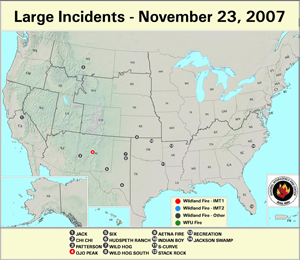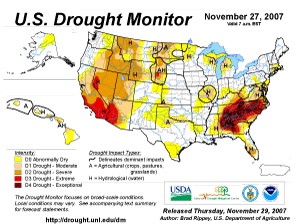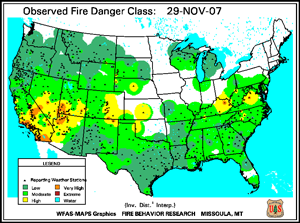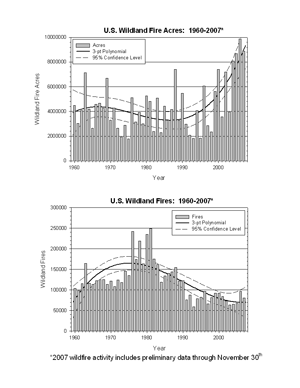Fire activity diminished across most of the western U.S. in November, with the exception of Southern California where several large blazes occurred. Wildfire activity also impacted central California at the end of the month.
Long–term moisture deficits, severe drought conditions, and strong Santa Ana winds aided in the development of several late season fires north of Los Angeles. The largest of these was the Corral wildfire in late November. This fire in the coastal mountains west of Malibu destroyed homes and generated a dense smoke plume. NASA satellite imagery from November 24th shows the extent of the offshore transport of the smoke plume.
As of November 30th, there have been over 80,200 wildland fires and more than 8.9 million acres had burned so far in 2007 according to the National Interagency Fire Center (NIFC).
The persistence of long–term rainfall deficits and severe–to–extreme drought conditions across much of the West have resulted in a region of extreme fire potential across the Southwest, according to the U.S. Forest Service (USFS) experimental fire potential index.
At the end of November, high to very high fire danger was observed across parts of Southern California, southern Nevada, southern Utah, and a large portion of Arizona. In addition, the fire danger was high across the Front Range of Colorado, along with areas of northeastern Kentucky and northern Virginia.
Dead fuel moisture levels have remained extremely dry across the western U.S. during November. The 10–hour fuel moisture levels on November 29th were exceptionally dry throughout most of the Southwest and Great Basin.
| Totals as of November 30th | Nationwide Number of Fires | Nationwide Number of Acres Burned |
|---|---|---|
| 11/30/2007 | 80,281 | 8,900,885 |
| 11/30/2006 | 91,437 | 9,580,472 |
| 11/30/2005 | 62,844 | 8,571,270 |
| 11/30/2004 | 64,488 | 8,077,514 |
| 11/30/2003 | 59,149 | 3,825,786 |
| 11/30/2002 | 71,644 | 7,124,849 |
| 11/30/2001 | 81,681 | 3,555,138 |
| 11/30/2000 | 91,094 | 7,309,887 |
| 5–yr average (2003 – 2007) |
71,640 | 7,791,185 |
| 10–yr average (1997 – 2006) |
75,425 | 6,877,350 |
Medium to larger fuels (i.e., the November 29th 100–hr and November 29th 1000–hr fuel moistures) were also very dry, with exceptionally dry fuel conditions across parts of Southern California and most of the Southwest (Arizona, New Mexico and Nevada).
The Keetch–Byram Drought Index (KBDI), a widely used drought index for fire risk, had the largest potential for wildland fire activity in the contiguous U.S. across a large portion of California, as well as over portions of Nevada and southwest Arizona. At the end of November, high KBDI values and increased fire potential were also observed across parts of the Carolinas, Georgia and Florida.
 NOAA's National Centers for Environmental Information
NOAA's National Centers for Environmental Information




